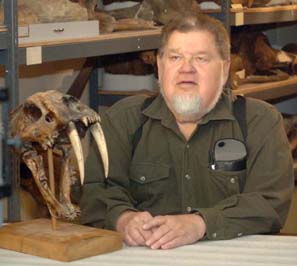Curator Akersten to be featured on National Geographic Channel sabertoothed cat program Aug. 19
August 16, 2007
Dr. William Akersten, Idaho Museum of Natural History curator of vertebrate paleontology who is an expert on the prehistoric sabertoothed cat, will be featured on the television program “Prehistoric Predators: Saber Tooth” airing at 10 p.m. Aug. 19 on the National Geographic Channel.  The National Geographic Channel airs on some cable and satellite TV networks. The program will also be broadcast Aug. 20 at 1 a.m. EST, Aug. 25 at 10 p.m. EST and Aug. 26 EST at 1 a.m. and Aug. 28 at 5 p.m. EST.
The National Geographic Channel airs on some cable and satellite TV networks. The program will also be broadcast Aug. 20 at 1 a.m. EST, Aug. 25 at 10 p.m. EST and Aug. 26 EST at 1 a.m. and Aug. 28 at 5 p.m. EST.
Last Halloween a television production firm, Creative Differences based in Los Angeles, came to the Idaho Museum of Natural History to film and interviewed Akersten about the sabertoothed cat for a session lasting about three hours.
The program on the sabertoothed cat is part of a three-episode series about late-Pleistocene carnivores. One episode will focus on the sabertoothed cat, while the others will showcase the short-faced bear and the Dire wolf.
Akersten was selected for the series because of his 15 years of experience at Rancho La Brea prior to coming to the IMNH. From 1972 to 1985, he worked for the Natural History Museum of Los Angeles County as coordinator of the Rancho La Brea Project, curator of Rancho La Brea, and curator of Pleistocene vertebrates. While there, Akersten worked closely on the sabertoothed cat fossil remains that were found in the tar pits, as well as the remains of other Pleistocene mammals collected there.
Akersten connected with the television production company through his contacts at La Brea. “Everybody who does anything with sabertoothed cats has to go through La Brea,” Akersten said. “One of my former assistants there talked with the production crew and suggested they contact me, so they did.”
“They are a strange creature,” Akersten said of the sabertoothed cat. “When you work with hundreds of them, you get interested.”
Akersten’s interest led him to publish a paper in 1985 showing that the sabertoothed cats could not stab with their canine teeth, but rather bit with them. “The structure of the muscles and bones of the jaw and cranium, along with the other teeth showed that stabbing was impossible,” Akersten explained.
The appearance in the program corresponds nicely with a project Akersten is working on for the ISU Department of Biological Sciences. In May 2008, ISU will host an international symposium on sabertoothed mammals and Akersten is heading up that effort. The symposium, which Akersten believes will have 40 to 50 attendees, will focus on various types of sabertoothed mammals including the sabertoothed cat.
Akersten graduated from Edgewood High in Ashtabula, Ohio, earned his bachelor’s and master's degrees from the University of Texas in Austin and his Ph.D. from the University of Michigan.
Categories:
